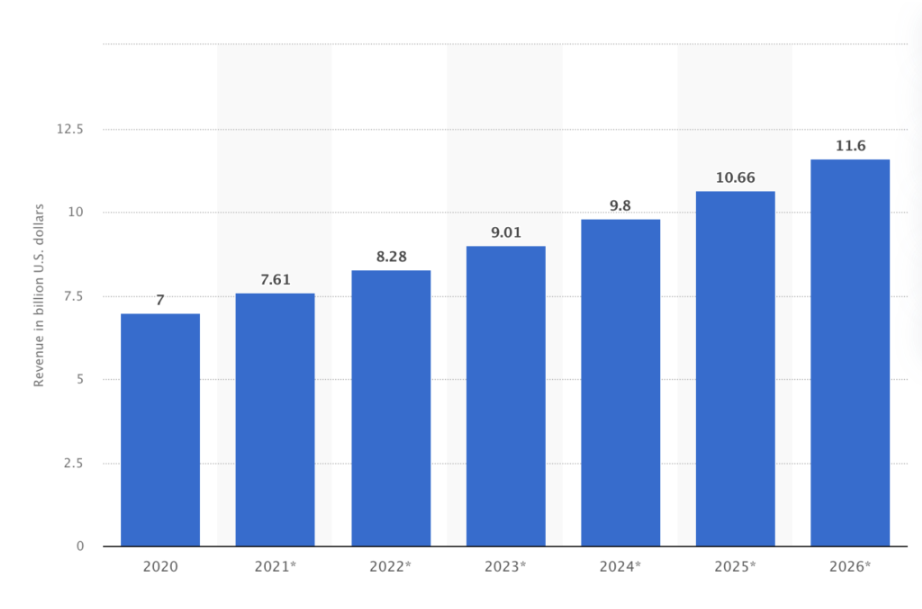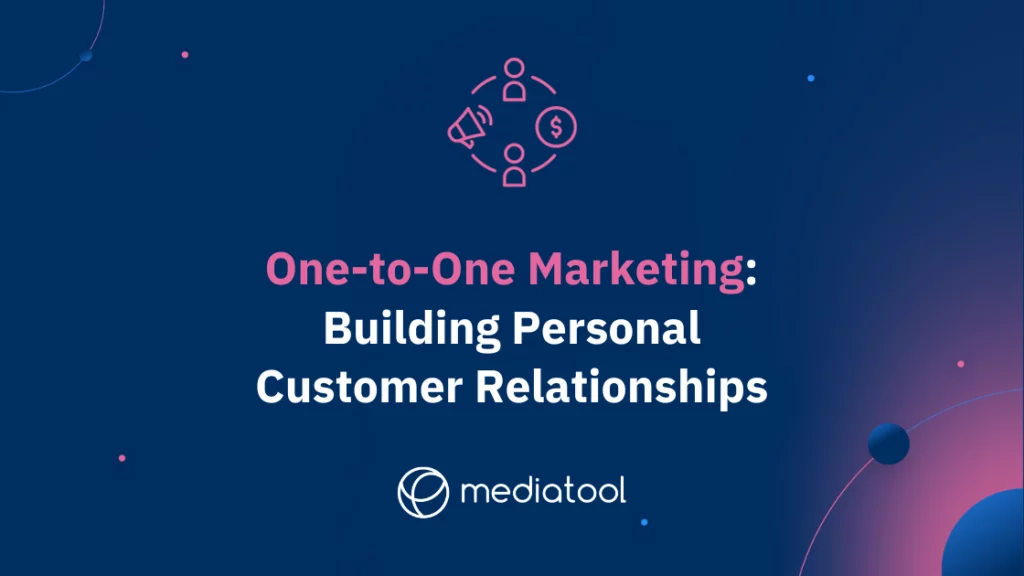One-to-one marketingis about getting to know each customer personally and tailoring your marketing efforts to their individual needs and preferences.
It’s not just about sending the same message to everyone, it’s about making each customer feel special and understood. The goal is to build trust and loyalty with each customer and ultimately boost sales.
Practiced correctly, it can increase the value of your customer base.
In this article we’ll break down one-to-one marketing and introduce steps and tips for getting started.
What is One-to-One Marketing?
One-to-one marketing, also known as personalized or relationship marketing, is a customer-centric marketing strategy focused on tailoring interactions and communications to individual customers. This approach leverages customer data, such as demographics, purchase history, and social and behavioral data, to create comprehensive customer profiles.
By understanding each customer’s unique needs and preferences, one-to-one marketing enables the creation of customized marketing strategies and personalized marketing messages.
To effectively implement one-to-one marketing, businesses collect customer data to track and monitor customer interactions. This data is instrumental in segmenting the customer base, enabling marketers to deliver personalized emails, offers, and promotional messages that resonate with individual customers.
Marketing automation tools and customer relationship management (CRM) systems play a crucial role in this process, providing valuable insights and helping businesses efficiently gather and analyze customer feedback.
The goal of one-to-one marketing is to build stronger customer relationships, enhance the customer experience, and boost customer loyalty. By providing a personalized experience, businesses can increase customer satisfaction, leading to improved retention and stronger brand loyalty. This strategy not only helps in cross-selling and up-selling but also in maximizing the customer lifetime value.
One-to-one marketing transcends traditional mass marketing techniques by focusing on individual customer interactions rather than a one-size-fits-all approach. Through channels like email, social media, and direct mail, businesses can create more relevant content and offers, significantly improving their marketing efforts and investment.
Ultimately, this strategy is about building personal relationships with customers, leading to long-term customer loyalty and increased sales.
Advantages of One-to-One Marketing
Enhanced Marketing Effectiveness
One-to-one marketing, often called relationship marketing, significantly surpasses traditional mass marketing methods in effectiveness. This customized marketing strategy centers on using customer data to develop comprehensive customer profiles.
This approach allows businesses to craft personalized marketing messages and offers, targeting individual customers based on their unique characteristics, needs, and preferences. The result is a higher engagement rate and increased conversions, as these personalized experiences are more likely to resonate with customers.
Building Trust and Customer Loyalty
Implementing one-to-one marketing fosters a sense of trust and loyalty among customers. This strategy, integral to customer relationship management, demonstrates a company’s commitment to addressing individual customer needs and preferences.
By delivering personalized experiences and interactions, businesses enhance customer satisfaction, fostering stronger customer relationships. This approach not only improves retention rates but also bolsters long-term brand loyalty.
Cost-Effectiveness and ROI Enhancement
One-to-one marketing proves more cost-effective compared to broad-scope mass marketing campaigns. By focusing on targeted groups within the customer base, companies can optimize their marketing efforts.
This targeted approach, aided by marketing automation tools and analysis of customer feedback and purchase history, leads to reduced marketing expenses. Additionally, it enhances the return on marketing investment (ROI) by directing resources toward customers more likely to respond positively, thereby boosting sales and customer lifetime value.
Long-Term Benefits
Overall, one-to-one marketing emerges as a powerful tool for businesses aiming to increase sales, build stronger customer relationships, and maximize their marketing strategy’s impact.
By leveraging customer data to create personalized marketing strategies, companies can not only improve immediate sales figures but also lay the groundwork for long-term customer loyalty and stronger brand relationships.
This approach, emphasizing the individual needs and preferences of each customer, marks a shift from mass marketing to a more nuanced, effective way of engaging with customers.
One-to-One Marketing Strategy Components
Customer Segmentation: Foundation of Personalization
One-to-one marketing strategy starts with effective customer segmentation. This process involves dividing the customer base into distinct groups based on their unique characteristics, behaviors, purchase history, and preferences.
This segmentation, often informed by social and behavioral data, allows businesses to create highly targeted marketing campaigns.
These campaigns are tailored to meet the specific needs and preferences of each segment, significantly increasing the effectiveness of marketing efforts and fostering stronger customer relationships.
Data Collection and Analysis: Unlocking Customer Insights
A pivotal component of one-to-one marketing is the collection and analysis of customer data. Businesses employ various methods such as surveys, analytics tools, and direct customer feedback to gather comprehensive customer profiles.
This collected data is then analyzed to gain valuable insights into individual customer’s needs and preferences.
By tracking and monitoring customer interactions, companies can refine their marketing strategies, ensuring they are aligned with customer expectations and behaviors, thereby boosting customer satisfaction and loyalty.
Personalization: Crafting Tailored Customer Experiences
Personalization stands at the core of one-to-one marketing strategies. It involves customizing products, services, and marketing messages to align with the specific needs and preferences of individual customers or customer segments.
This can range from sending personalized emails and promotional messages to developing customized offers and services.
The goal of personalization is to create a unique and relevant customer experience for each individual, which not only increases the likelihood of conversions but also strengthens long-term customer loyalty.
Overall Impact on Marketing and Sales
Implementing these components of one-to-one marketing – customer segmentation, data collection and analysis, and personalization – is crucial for businesses aiming to enhance their marketing strategies.
This approach not only helps in building stronger brand loyalty and customer relationships but also plays a significant role in increasing sales.
By focusing on individual customers and their specific needs, companies can create more effective, personalized marketing campaigns, leading to improved ROI and customer lifetime value.
One-to-one marketing is a powerful tool for businesses seeking to optimize their marketing efforts and foster enduring customer relationships.
In 2023, the global revenue of customer experience personalization and optimization software is projected to surpass nine billion U.S. dollars.

Steps to Launching One-to-One Marketing Campaigns
Ready to get personal with your customers? Launching one-to-one marketing campaigns is the way to go.
Here are the steps you need to take to get started:
1. Identify your target audience:
One-to-one marketing campaigns are all about targeting specific customers, so it’s essential to identify who you want to reach.
Customer segmentation is a powerful tool that can help you divide your customer base into groups based on demographics, behavior, or other factors.
By identifying your target audience, you’ll be able to create campaigns tailored to their specific needs and interests.
2. Collect and analyze customer data:
To create effective one-to-one marketing campaigns, you must deeply understand your target audience.
This means gathering data on their demographics, buying habits, and interests. You can use various tools and techniques to collect this data, such as surveys, analytics, and customer feedback.
Once you have this data, you’ll need to analyze it to uncover insights that will inform your personalization strategy.
3. Develop a personalized marketing strategy:
With a deep understanding of your target audience, you can develop a strategy for personalizing your messages, products, and services.
This might include tailoring your messaging to specific segments of your customer base, creating targeted offers and promotions, or developing customized products and services.
Using your collected data to create a strategy that will resonate with your target audience and drive conversions.
4. Implement your strategy:
Once you have a personalization strategy, it’s time to start delivering personalized messages and offers to your target audience. This can be done through various channels, including email, social media, and your website.
You’ll need to use the tools and technologies to deliver these messages effectively. For example, you might use a CRM system to segment your audience or a marketing automation platform to send targeted emails.
5. Measure and optimize:
As you launch your one-to-one marketing campaigns, tracking their effectiveness and making adjustments as needed is important. Use analytics to monitor how your campaigns are performing, such as open rates, click-through rates, and conversion rates.
Based on this data, you can change your strategy and tactics to optimize your campaigns and improve their results. By regularly measuring and optimizing your campaigns, you’ll be able to improve their effectiveness over time.
Tips for Using One-to-One Marketing
Here are some tips to help you make the most of your one-to-one marketing efforts:
Be consistent:
Use the same tone, voice, and messaging across your one-to-one marketing campaigns to create a sense of consistency and trust with customers. This will help to build a strong brand identity and make it easier for customers to recognize your communications and offers.
Get creative:
- Feel free to get creative with your one-to-one marketing campaigns.
- Experiment with different formats and channels such as email, SMS, and social media.
- Try other tactics like gamification, personalized videos, and storytelling to see what works best for your target audience.
- Be open to trying new things, it can help you stand out and increase the effectiveness of your campaigns.
One-to-One Marketing Examples
Some examples of one-to-one marketing include personalized email campaigns, targeted social media ads, and product recommendations.
It’s all about using data and technology to get to know your customers on a personal level and create customized experiences that speak to them.
For instance, take Amazon. They use customer data to recommend products to individual customers based on their browsing and purchase history. You’ll probably get some shoe recommendations if you’ve been checking out running shoes. It’s like they know you better than you know yourself!
Another example is Netflix, they use data on customers’ viewing habits to create personalized recommendations for TV shows and movies. If you’ve been binging on crime dramas, you’ll probably start seeing more crime dramas pop up in your recommendations. It’s like they know exactly what you want before you know it!
These are just a few examples of how companies use one-to-one marketing to create personalized customer experiences. By understanding their customers’ needs and preferences, companies can create tailored experiences that are more likely to drive engagement, loyalty, and sales.
The Future of One-to-One Marketing
The future of one-to-one marketing is likely to be shaped by advances in technology and data analysis. With the increasing use of artificial intelligence and machine learning, companies will be able to gather and analyze customer data more effectively, allowing them to create even more personalized marketing campaigns.
Additionally, the rise of virtual and augmented reality technologies will enable companies to create more immersive and personalized customer experiences.
Another trend likely to shape the future of one-to-one marketing is the growing use of voice assistants and chatbots. These technologies will allow companies to interact with customers in more natural and conversational ways, making it easier to gather data and deliver personalized messages and offers.
As these technologies become more sophisticated, they can quickly understand and respond to customers’ needs and preferences.
Finally, blockchain technology will also likely play a role in the future of one-to-one marketing, allowing companies to create secure and transparent customer data management systems. With blockchain, customer data can be stored in a decentralized and tamper-proof way, helping to protect customer privacy and increase trust in the companies that collect and use that data.
Wrapping up And What’s Next
One-to-one marketing is all about setting up a solid foundation for success. This includes getting a plan in place, tracking your marketing campaigns and putting reporting systems in place. By taking these steps, you will be able to get the most out of your efforts and see real results. To make this process even easier, schedule a tour of Mediatool today. With Mediatool’s help, you can streamline your marketing efforts, and take the guesswork out of your campaigns.





